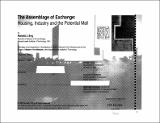| dc.contributor.advisor | Fernando P. Domeyko. | en_US |
| dc.contributor.author | Eng, Ronald J. (Ronald Jan) | en_US |
| dc.date.accessioned | 2011-09-13T17:38:15Z | |
| dc.date.available | 2011-09-13T17:38:15Z | |
| dc.date.copyright | 1994 | en_US |
| dc.date.issued | 1994 | en_US |
| dc.identifier.uri | http://hdl.handle.net/1721.1/65691 | |
| dc.description | Thesis (M. Arch.)--Massachusetts Institute of Technology, Dept. of Architecture, 1994. | en_US |
| dc.description | Includes bibliographical references (p. 171-178). | en_US |
| dc.description.abstract | This thesis is interested in examining a contemporary generative method for approaching design in urban areas. It considers the levels of interactions in the city in which the questions of architecture are clearly affected by the conditions of this new information age. One cannot ignore that within the built living-working dynamic of the modern city there are new circumstances emerging that may generate new building types. For example, the viability of the "home-office" can offer new advantages socially, economically and culturally, but also present particular difficulties for issues of public and private. Similarly, the reemergence of a new industrial city with its light industries (computer science, biological, pharmaceutical and genetics etc.) brings new conditions and (anti-zoning) possibilities for inhabiting varying uses in close proximity. The initial assumption is that any intervention in the urban landscape must recognize action of the physical / spatial field of the built environment with the patterns of use and culture. It specifically asks that the architecture be rooted in time and place. With that assumption, the design philosophy must be inclusive of the needs and conditions of the setting in question. My observations and experiences have led me to believe that a strength within the complexities of urban life, is in the potential for exchange in many aspects of city living. Given the densities and information technologies available and the range of inhabitants' experiences and cultures involved, one can claim that the situation of the city can be enriched by an architecture of built reciprocity at the many sizes and perceptions. Concurrently with the consideration of technology's effect not only on specific architectural situations but also upon the design methodology, an aspect of this thesis probes the influence of computational tools (as well as traditional techniques) upon its architecture. The vehicle for these ideas is in the design of a multi-use development for the city of Cambridge, Massachusetts. It an interpretation of a current proposal, of which a 2.3 million square foot program and site have been adapted. | en_US |
| dc.description.statementofresponsibility | by Ronald J. Eng. | en_US |
| dc.format.extent | 180 p. | en_US |
| dc.language.iso | eng | en_US |
| dc.publisher | Massachusetts Institute of Technology | en_US |
| dc.rights | M.I.T. theses are protected by
copyright. They may be viewed from this source for any purpose, but
reproduction or distribution in any format is prohibited without written
permission. See provided URL for inquiries about permission. | en_US |
| dc.rights.uri | http://dspace.mit.edu/handle/1721.1/7582 | en_US |
| dc.subject | Architecture | en_US |
| dc.title | The assemblage of exchange : housing, industry and the potential mall | en_US |
| dc.type | Thesis | en_US |
| dc.description.degree | M.Arch. | en_US |
| dc.contributor.department | Massachusetts Institute of Technology. Department of Architecture | |
| dc.identifier.oclc | 30758969 | en_US |

